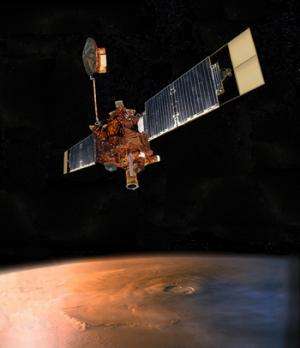Whatever happened to . . . the Mars Global Surveyor?

On September 11, 1997, the Mars Global Surveyor slipped into orbit around the Red Planet. Like JPL's Mariner and Viking missions before it, MGS (as it was affectionately known) fundamentally changed our view of Mars. First came the flybys, each of which returned close-up pictures of landscapes unlike anything anyone had ever seen before—and completely unlike one another. Even the orbiters that followed didn't truly provide a complete picture, says Arden Albee, professor of geology and planetary science, emeritus, and the MGS project scientist. "They didn't have the coverage, or the resolution. What we had was the blind men and the elephant; after MGS there could be no more global surprises."
Before finally falling silent in November 2006, MGS had returned data from Mars for longer than any other spacecraft in history, and had outlasted its planned lifetime four times over. Over nearly a decade, MGS had beamed back more than 240,000 images that, among other things, helped determine the landing sites for JPL's Spirit, Opportunity, and Curiosity rovers.
MGS's mapping spectrometer discovered a vast plain of coarse-grained hematite—a type of iron oxide that on Earth typically forms in hot water, such as a volcanic spring. When Opportunity landed on that Martian plain in 2004, the expected layer of hematite-rich rock proved instead to be uncountable numbers of individual, BB-sized "blueberries"—so named for their blue hue in Opportunity's false-color images—little concretions of iron ore whose shapes could only have grown within layers of wet sediment. And MGS's high-resolution camera revealed the Grand–Canyon–like layering of what is now known as Mount Sharp, at the foot of which Curiosity has just landed.
MGS was assembled from spare parts for JPL's Mars Observer, which was lost during its final approach to Mars in August 1993 after what may have been a fuel-line rupture. Both the Mars Observer and the Mars Global Surveyor combined " a weather satellite and a LANDSAT into a single orbiter," Albee wrote in Caltech's Engineering & Science magazine in 2001. "The instruments are co-aligned so that they all look at the same piece of land, and they always face Mars so that we get round-the-clock data," he added, noting that "it's quite a challenge for spacecraft designers to keep the instruments pointed at Mars, the high-gain antenna aimed at Earth, and the solar arrays facing the sun all at the same time—you have to use lots of wrist joints!" These joints, which mimic the flexibility of human wrists, allow each of these various components to be tilted independently in any direction.
However, one wrist joint was very nearly the spacecraft's undoing, Albee wrote. "When we unfolded the solar panels for the flight to Mars, there was quite a clunk, and one panel's wrist was damaged. This turned out to be a blessing in disguise, but it could have been catastrophic."
How did a group of clever JPL engineers prevent the Mars Global Surveyor from joining the Mars Observer in oblivion? Why was that sprained wrist a blessing in disguise? What else did MGS discover? Read "Mars Global Surveyor: A Success by Any Measure" in E&S online.
Provided by California Institute of Technology


















